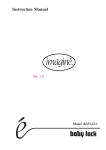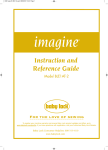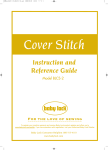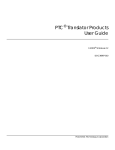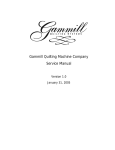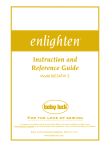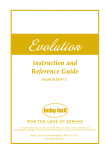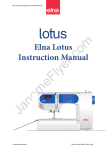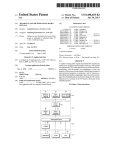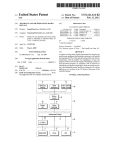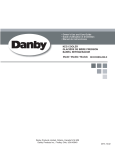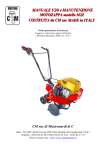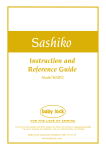Download Baby Lock Model BLCS Instruction manual
Transcript
INSTRUCTION MANUAL Model BLCS "IMPORTANT SAFETY INSTRUCTIONS" When using overlock machine, basic safety precautions should always be followed, including the following. Read all instructions before using this overlock machine. DANGER- To reduce the risk of electric shock. 1. The overlock machine should never be left unattended when plugged in. Always unplug this overlock machine from the electrical outlet immediately after using and before cleaning. 2. Always unplug before replacing light bulb. Replace bulb with same type rated 15 watts/110 volts in 110V/120V area. (15 watts 240 volts in 220V/240V area.) WARNING- To reduce the risk of burns, fire, electric shock, or injury to persons. 1. Do not allow to be used as a toy. Close attention is necessary when the sewing machine is used by or near children. 2. Use this overlock machine only for its intended use as described in this manual. Use only attachments recommended by the manufacturer as contained in this manual. 3. Never operate this overlock machine if it has a damaged cord or plug, if it is not working properly, if it has been dropped or damaged, or dropped into water. Return the overlock machine to the nearest authorized dealer or service center for examination, repair, electrical or mechanical adjustment. 4. Never operate the overlock machine with any air openings blocked. Keep ventilation openings of the overlock machine and foot controller free from the accumulation of lint, dust, and loose cloth. 5. Never drop or insert any object into any opening. 6. Do not use outdoors. 7. Do not operate where aerosol (spray) products are being used or where oxygen is being administered. 8. To disconnect, turn the main switch to the symbol "O" position which represents off, then remove plug from outlet. 9. Do not unplug by pulling on cord. To unplug, grasp the plug, not the cord. 10. Keep fingers away from all moving parts. Special care is required around the overlock machine needle. 11. Always use the proper needle plate. The wrong needle plate can cause the needle to break. 12. Do not use bent needles. 13. Do not pull or push fabric while stitching. It may deflect the needle(s) causing it to break. 14. Switch the overlock machine to the symbol "O" position when making any adjustments in the needle area, such as threading needle, changing needle, threading looper, or changing presser foot, and the like. 15. Always unplug the overlock machine from the electrical outlet when removing covers, lubricating, or when making any of the user servicing adjustments mentioned in the instruction manual. 16. Keep fingers away from moving parts, especially the area near the blades. 17. Please note that on disposal, this product must be safely recycled in accordance with relevant National legislation relating to electrical / electronic products. If in doubt please contact your retailer for guidance. European Union only 18. The appliance is not intended for use by young children or infirm persons without supervision. 19. Young children should be supervised to ensure that they do not play with the appliance. "SAVE THESE INSTRUCTIONS" "This overlock machine is intended for household use." Welcome to the Baby Lock Cover Stitch Machine Your Baby Lock Cover Stitch machine provides a variety of chain and cover stitches, allowing you to create professional looking hems just like the ready-to-wear fashions in stores. A variety of stitch widths and lengths also provide options for creating the look you want. Your Baby Lock Cover Stitch is a high-quality, dependable machine. The patented Jet-Air Threading system makes threading the looper a breeze. Speedy at 1300 stitches per minute, BLCS allows you to complete hems quickly. Other features including differential feed,auto-tension release when the presser foot is lifted, and manual tension adjustments put you in control of your project. With proper care and maintenance, your Baby Lock Cover Stitch machine promises years of high-quality, dependable performance and sewing pleasure. Keep this instruction manual as a step-by-step guide to become familiar with your Baby Lock. Happy Sewing! For additional product information visit our website at www.babylock.com 1 T A B L E O F C O N T E N T S 2 Table of Contents OVERVIEW ..................................................................................................................4 How Your Machine Operates ................................................................................ 4 Overview of the Baby Lock ................................................................................... 5 Accessories ............................................................................................................. 6 Needles ..................................................................................................................7 Thread ..................................................................................................................7 Optional Accessories.............................................................................................. 7 Accessory Adapter ..................................................................................................7 Setting Up Your Baby Lock................................................................................ 8/9 Side Cover .............................................................................................................. 9 Thread Cutter...................................................................................................... 10 Presser Foot Pressure Adjustment..................................................................... 10 Snap-on Presser Foot .......................................................................................... 10 Stitch Length ....................................................................................................... 11 Differential Feed.................................................................................................. 11 Chain/Cover Stitch Tension Dials ...................................................................... 12 Needle Tension Dial............................................................................... 12 Chain Looper Tension Dial.................................................................... 12 THREADING ................................................................................................................13 Threading Preparation........................................................................................ 13 Threading Your Baby Lock ................................................................................. 13 Locked Position for Threading............................................................................ 13 Thread Stand and Thread Port Reference Chart .............................................. 13 Chain Looper ........................................................................................................14 Chain/Cover Needles........................................................................................... 15 Left Needle - C-1.................................................................................... 15 Center Needle - C-2 ............................................................................... 15 Right Needle - C-3 ................................................................................. 15 How to Use the Needle Threader ....................................................................... 16 Front Cover Seam Guide .................................................................................... 16 Re-threading Looper ............................................................................................16 Start to Sew ......................................................................................................... 17 To Chain-Off of the fabric.....................................................................................17 Table of Contents (Cont.) CHAIN/COVER STITCH ............................................................................................ 18 Chain Stitching .............................................................................................. 18/19 Chain Stitch - Tension Adjustment...................................................... 19 Cover Stitch - Right Narrow - 3mm ............................................................. 20/21 Cover Stitch Tension Adjustment ......................................................... 21 Cover Stitch - Left Narrow - 3mm................................................................. 22/23 Cover Stitch Tension Adjustment ......................................................... 23 Cover Stitch - Wide - 6mm............................................................................. 24/25 Cover Stitch Tension Adjustment ......................................................... 25 Triple Cover Stitch - 6mm ............................................................................. 26/27 Triple Cover Stitch Tension Adjustment .............................................. 27 TECHNIQUES...............................................................................................................28 Turning Corners - Chain Stitch.......................................................................... 28 Turning Corners - Cover Stitch .......................................................................... 28 Flat Hemming - Cover Stitch ............................................................................. 29 Hemming in the Round - Cover Stitch............................................................... 29 Securing Chain and Cover Stitching.................................................................. 30 SPECIALTY THREADS ............................................................................................... 31 Using Specialty Threads..................................................................................... 31 Lightweight Threads........................................................................................... 31 Mediumweight Threads ...................................................................................... 31 Heavyweight Threads ......................................................................................... 31 Bypassing the Threading Port............................................................................ 32 Looper Threading Tool ........................................................................................ 33 Thread Cradle for Looper ................................................................................... 34 Specialty Thread Guide Chart ........................................................................... 35 MAINTENANCE .......................................................................................................... 36 Troubleshooting.............................................................................................. 36/37 Replacing Needles ............................................................................................... 38 Replacing Light Bulb .......................................................................................... 39 Cleaning............................................................................................................... 40 TECHNICAL DATA...................................................................................................... 41 Technical data ..................................................................................................... 41 STITCH SELECTION CHART .................................................................................... 42 Chart for Stitch Selection Setting for Chain/Cover ................................................... 42 T A B L E O F C O N T E N T S 3 O V E R V I E W 4 How Your Machine Operates Awareness of its simple operation will enable you to become more proficient in its use. Please read all instructions before using your new machine. Use one, two or three chain/cover stitch needles and one looper for a chain or cover stitch. When forming a chain stitch, the chain needle thread catches the chain looper to form a straight stitch on the top of your fabric and thread chain loops on the underside. Use 2 or 3 cover stitch needles and the chain looper to form a double or triple row of straight stitching on the top and a weave of thread on the underside of your fabric. After setting up your machine for the first time, take a few moments to learn how it sews. Before your machine is threaded, turn the handwheel toward you and watch the operation of the various parts. Overview of the Baby Lock 1. Presser foot pressure adjusting screw 16. Accessory compartment & spool stand 2. Machine lock button release lever 17. Differential feed adjusting lever 3. Machine lock button 18. Left needle tension dial 4. Presser foot thread release lever* 19. Center needle tension dial 5. Looper threading lever 20. Right needle tension dial 6. Thread cutter 21. Looper tension dial 7. Needle height viewing area 22. Needle drop drawer 8. Needle clamp screw 23. Chain looper threading port 9. Needle plate 24. Telescopic thread guide and antenna 10. Snap-on presser foot 25. Power switch 11. Side cover 26. Attachment screw holes O V E R V I E W 12. Front table 13. Handwheel * Raising the presser foot releases needle 14. Carrying handle threads. 15. Stitch length dial 4 24 1 6 18 19 20 14 7 16 23 8 10 9 11 21 25 5 13 15 17 3 26 2 22 12 5 O V E R V I E W 6 Accessories Your Baby Lock has a built-in accessory compartment. To open, swing the "lid" on the thread spoolstand to the right to reveal the tray holding some of the accessories listed below. Others may be found in the machine packing materials. Accessory Number included Instruction manual Guide fixing screws for table Lint brush/needle insert tool Package of assorted sized needles Schmetz ELx705CF Allen screwdriver Tweezers Needle threader Chain/Cover stitch needle screws Accessory adapter(for Optional Accessories) Looper threading tool Screwdriver Machine cover Mounting bolt with washer(U.S.A. only) Thread nets Spool caps Sponge disks Cone holders Located in 1 2 1 1 Packing box Accessory compartment Accessory compartment Accessory compartment 1 1 1 2 1 1 1 1 1 4 4 4 4 Accessory compartment Accessory compartment Accessory compartment Accessory compartment Accessory compartment Accessory packet Accessory packet Accessory packet Accessory packet Accessory packet Accessory packet Accessory packet On machine Needles Your Baby Lock is set up with Schmetz ELx705CF needles size 90/14. This is suitable for most medium and heavyweight fabrics. For lightweight fabrics use size 80/12, ELx705CF needles. The ELx705CF needle is a semi-ballpoint design and is suitable for knits and wovens. Thread All types of thread may be used on your Baby Lock, but 100% long-staple polyester thread, crosswound on a cone, consistently provides the best stitch performance. Because the threads must pass through several thread guides at high speeds, they must be of uniform thickness and high strength with a minimum amount of linting. Good-quality cotton or cotton-covered polyester threads sew well, though they produce more lint, creating the need to clean the machine more frequently. Poor grades of thread can result in frequent fraying, breaking and unbalanced stitches. O V E R V I E W Threads of other fiber contents and weights may be used, depending on their strength and thickness. Testing will help you determine how easily they can pass through the thread guides, thread slots, needles and loopers. Important Note: For maximum performance of the Baby Lock, it is recommended to use "100% polyester-long fiber thread". Recommended brands are Maxi-Lock and Metrosene. This thread also performs best when used with many decorative threads for sewing specialty decorative techniques. Optional Accessories CHAIN/COVER STITCH OPTIONAL ACCESSORIES Belt Loop Folder (3/4" & 1-1/2")-(19mm & 38mm) Double Fold Bias Binder (1-1/8" & 1-3/8")-(28mm & 36mm) Elastic Gatherer Bracket Elastic Guide for Gatherer Bracket (1/4", 3/8" & 1/2")-(7.5mm, 10mm, & 13mm) Fabric Guide Pintuck Foot with 2 guides Plain Hemmer (1/4" & 1/2")-(7mm & 13mm) Single Downturn Feller (1/4", 5/8" & 1")-(7mm, 16mm & 25mm) Knit / Woven Double Fold Bias Binder (8mm, 10mm, &15mm) NOTE: Use the front two Attachment Screw Holes for the Knit / Woven Double Fold Bias Binder. Use the back two Attachment Screw Holes with the Accessory Adapter for the Optional Accessories. These optional accessories are available at your Baby Lock retailer. Accessory Adapter Place Accessory Adapter over the back two holes of the front cover table. Place the accessory bracket on top of the Accessory Adapter. Insert the Guide Fixing Screws to hold the Accessory Adapter and Accessory in place. 7 O V E R V I E W Setting Up Your Baby Lock 1. Remove machine from box After removing the packing materials from the box, gently lift your Baby Lock by grasping the handle provided on the top of the machine. Place the machine on a sewing table or any level surface that provides ample work area to the left. Place the foot controller in a pedal stay, if desired, and place it under the sewing table. 2. Plug in the machine A Plug the power cord into the machine first, then into a wall outlet. The power switch is located toward the back on the right side of the machine. Always make sure the power is off when the machine is not in use (fig. A). Available foot controller for U.S.A.: Model YC-482 or YC-420W. 3. Polarized plug This appliance has a polarized plug (one blade wider than the other). To reduce the risk of electric shock, this plug is intended to fit in a polarized outlet only one way. If the plug does not fit fully in the outlet, reverse the plug. If it still does not fit, contact a qualified electrician to install the proper outlet. Do not modify the plug in any way. 4. Foot controller The sewing speed of the machine is determined by the amount of pressure applied to the foot controller. When not in use, do not place anything on the foot controller, or the machine could start inadvertently and the controller or motor could burn out. 8 Setting Up Your Baby Lock 5. Position the telescopic thread guide. Raise the telescopic thread guide to its highest position. Rotate the shaft to the left and right until each section "clicks" into a locked position (fig. B). 6. Opening Front table B To open the front table, place your thumb against the tab, and slide the cover to the right. A slight pull toward you will allow the cover to swing down, providing access to the chain looper. (fig. C). O V E R V I E W C Side Cover Open side door on the left for easy access to the chain looper thread tray. Close door before sewing. 9 O V E R V I E W Thread Cutter There is a thread cutter located on the left side of your machine. At the end of a seam, sew off the fabric edge and continue sewing to create a 5 - 6 inch(12 - 15cm) thread chain. Bring the chain of thread up and back and pull forward into the thread cutter. Presser Foot Pressure Adjustment The presser foot pressure has been preset at the factory and rarely needs adjustment. You may find it necessary, however, to decrease the pressure for thick fabrics or increase pressure for thin fabrics to feed more smoothly under the foot. Use a coin to turn the screw on top of the machine. To increase pressure, turn the pressure adjusting screw clockwise. To decrease pressure, turn the screw counterclockwise. Snap-On Presser Foot The Baby Lock has the convenience of a snap-on presser foot. To Release: 1. Raise the presser foot lever. This will also lower the feed dogs out of the way. 2. Raise the needles to the highest position. 3. Push the presser foot release lever located at the back of the presser foot holder. 4. Slide the presser foot to the left of the needles. Presser Foot Release Lever To Replace: 1. Raise the presser foot lever.This will also lower the feed dogs out of the way. 2. Raise the needles to the highest position. 3. Slide the foot from the left to right. 4. Align the bar to the foot with the groove in the holder. 5. Lower the presser foot lever to snap into place. 6. Turn the hand wheel counter clockwise to engage the feed dogs in the up position. The raised markings on the toe of the foot are seam line guides. They indicate the needle positions to help guide your fabric for accurate seaming. 10 Stitch Length The stitch length adjusting dial is conveniently located just to the left of the front cover, near the base plate (fig. A). The dial shows the stitch-length ranging from 1, for the shortest stitch, to 4 for the longest. B A Simply turn the dial aligning the desired setting with the indicator mark on the machine. A stitch length of 3mm, or about 10 stitches per inch is ideal for most fabrics. For seaming very lightweight fabrics, you may prefer a shorter stitch length. When sewing heavier fabrics, you may choose to lengthen the stitch (fig. B). O V E R V I E W Differential Feed Your Baby Lock serger is equipped with differential feed.The set of feed dogs work independently in order to ensure smooth sewing on all fabrics (fig. A) When the differential feed adjusting lever, located at the machine's right, front edge is set on "N" for normal feeding, the feed dogs move the same distance. This is the setting to use for most fabrics and applications (fig. B). A When the dial is set above "N", the front feed dog will feed more fabrics than the back. This is because the front feed dog moves at a greater distance than the back feed dogs. As a result, the fabric becomes compressed or eased, as the diagram on the front cover indicates. This can eliminate wavy seams in stretchy fabrics or those cut on the bias grain. At the maximum setting of 2.0 (fig. C), the differential feed can gather a lightweight fabric to nearly double fullness (fig. D). The front feed dog is actually feeding in twice as much fabric as the back feed dog is feeding out. To maximize the gathering effects, use the longest stitch length setting. Fabric weight will affect the gathering. Test stitch for desired results. B D When the differential feed lever is set below "N" (fig. F), the front feed dog moves less distance than the back feed dog. This adjustment stretches the fabric slightly as it is sewn. The lower settings prevent puckers on lightweight fabric (fig. E). C E F 11 O V E R V I E W Needle Tension Dials From left to right the dials are: Red for C1 chain needle, Yellow for C2 chain needle and Green for C3 chain needle. The tension settings range from 0 to 9. The fabric and thread that you are working with will determine what the tension setting will be. Be sure to sew test after changing the settings. Chain Looper Tension Dial The chain looper dial is color coded blue for easy identification. The tension settings range from 0 to 9. The fabric, thread and stitch that you are working with will determine what the tension setting will be. Be sure to sew test after changing the settings. 12 Threading Preparation When using overlock threads (cones) place the cone securely over the spool holder on your machine. The spool holders prevent the cone from spinning, enabling the thread to feed evenly. (fig. A) When using standard sewing thread spools, use the sponge disks (sponge side up) and spool caps (on top of spool) to prevent the thread from tangling. (fig. B) A Cones with Spool Holder Thread nets can be placed over threads that tend to slip off the spool during sewing. For example: rayon, silk, nylon, invisible, and decorative threads. Place the thread net over the spool of thread and fold net back, (fig. C) Pull thread from the top of spool to enable the thread to feed evenly. (fig. D) B Standard sewing thread with sponge disks and spool cap. C Thread net on thread T H R E A D I N G D Pulling thread through net Threading Your Baby Lock Your Baby Lock is equipped with an exclusive "Instant Jet-Air Threading System" for fast, easy threading of the chain looper. One push of the "Jet-Air" threading lever will automatically thread the chain looper. It is no longer necessary to use tweezers for threading the thread guides. If a looper thread breaks or runs out, just re-thread it. There is no need to follow threading sequence. Locked Position for Threading 1. Open the front cover. 2. Raise the presser foot to release all threads. 3. Depress the machine lock button firmly. Rotate the machine handwheel slowly toward you until the button "snaps" into the locked position and the lock button release lever moves to the far left (fig.A). A Note: The Baby Lock must be in the locked position when threading the looper unless otherwise indicated. 13 T H R E A D I N G Chain Looper 1. With the presser foot up and machine lock button in the locked position, see fig. A page 13. 2 Place the thread cone or spool on the "Chain Looper" spool pin. Slip the thread into the telescopic antenna thread guide above the thread cone. 3. Insert the thread through the hole of the thread guide above the chain looper tension dial. Bring the thread under the chain looper tension dial, then up and over the left thread guide,making sure the thread is in the tension disk. (See fig.A). 4. Take the thread down to the chain looper threading port. 5. Pull 18 inches (40cm) of thread and insert 1 inch (10cm) of thread into the chain looper threading port. Use tweezers if necessary, to insert the thread end. (See fig. B). 6. Depress the looper threading lever. (See fig. B). If the thread does not go through the chain looper eye with one push, depress the threading lever again until it does. 7. Open side cover to the left for easy access to the chain looper thread in tray. See fig. C. 8. Trim excess thread to 4 inches (2.5cm) from the eye of chain looper and leave it hang. 9. Close side cover. 10. Move the lock button release lever to the right. A Chain Looper Thread Tray Side Cover 14 B C Chain / Cover Needles Left Needle C-1 1. Raise presser foot and place the thread on the far left spool pin. Slip the thread into the telescopic antenna thread guide directly above the thread spool. See drawings below for reference. 2. Bring thread down from the telescopic antenna, snap thread into the red thread guide on the top of the machine, and then down into the red hole above the tension dial. 3. Bring the thread down the right side of the red tension dial, under the dial and back up the left side, making sure the thread is in the tension disk. 4. Bring the thread through thread guide at top of machine and down to the pre-tension thread guide above the needle. 5. Pass the thread from the left side behind the pre-tension thread guide plate on needle clamp and into thread guide above the needle. See drawings below for reference. 6. With the needle threader or tweezers in the accessory compartment, thread needle in the left "C-1" needle position. Center Needle C-2 1. Raise presser foot and place the thread on the second from the left spool pin. Slip the thread into the telescopic antenna thread guide directly above the thread spool. See drawings below for reference. 2. Bring thread down from the telescopic antenna, snap thread into the yellow thread guide on the top of the machine, and then down into the yellow hole above the tension dial. 3. Bring the thread down the right side of the yellow tension dial, under the dial and the thread guide below the dial. 4. Bring the thread through thread guide at top of machine and down to the pre-tension thread guide above the needle. 5. Pass the thread from the right side behind the pre-tension thread guide plate on needle clamp and into thread guide above the needle. See drawings below for reference. 6. With the needle threader or tweezers in the accessory compartment, thread needle in the center "C-2" needle position. T H R E A D I N G Right Needle C-3 1. Raise presser foot and place the thread on the back right spool pin. Slip the thread into the telescopic antenna thread guide directly above the thread spool. See drawings below for reference. 2. Bring thread down from the telescopic antenna, snap thread into the green thread guide on the top of the machine, and then down into the green hole above the tension dial. 3. Bring the thread down the right side of the green tension dial, under the green dial and under the thread guide located below the yellow tension dial. 4. Bring the thread through thread guide at top of machine and down to the pre-tension thread guide above the needle. 5. Pass the thread from the right side behind the pre-tension thread guide plate on needle clamp and into thread guide above the needle. See drawings below for reference. 6. With the needle threader or tweezers in the accessory compartment, thread needle in the right "C-3" needle position. NOTE: After threading the needles, the thread is then place to the left and top of the presser foot. 15 T H R E A D I N G How To Use The Needle Threader A 1. Hold the needle threader with the arrow mark on top. Place the thread in the groove of the needle threader. (fig.A) 2. Push the needle threader against needle and slide down the groove of the needle to the eye. Push the thread into the eye of the needle. 3. With a point of the needle threader or the tweezers pull the loop of thread from the back of the needle, under the foot and to the back left. B Front Cover Seam Guide There are marks on the bed of the Baby Lock that can be used as a guide while sewing. It will depend on what cover or chain stitch needle position you will be using as to what the width will be. For example, the first mark on the left closest to the needle plate, C-1 needle is 1 inch (2.5cm), C-2 needle is 7/8 inch (2.25cm), and C-3 needle is 3/4 inch (2cm). This guide is great for hemming garments with cover stitch. 1. Turn under hem and press. 2. Align the raw edge of the hem with the needles 3. Align the folded edge of hem with the correct guide mark. Re-threading Looper If a thread breaks, raise the presser foot and pull the broken thread from under the foot. Open the front table, depress the machine lock button.. Re-thread the machine above the threading port, leaving an 18inch (40cm) thread tail. Thread the looper as usual and move lock button release lever to the right. Close the front cover and sew a test sample. Note: When re-threading your Baby Lock using the "Jet-Air Threading" feature, make sure that the previous thread that was in the looper (tube) is completely removed. This will eliminate any chance of the previous thread obstructing the flow of the air when re-threading the machine. 16 Start to Sew When threading is complete, the loose threads should initially interlock on fabric. This is most important when sewing the chain or cover stitches. 1. Cut all threads to 4 inch (10cm) in length. All threads should then be placed over the top and left of the presser foot. The threads at this time cannot be placed under the presser foot. A 2. Place the fabric under the presser foot directly below the needles (fig. A). 3. Lower the presser foot. 4. Turn the handwheel toward you to form 2 or 3 stitches. B T H R E A D I N G 5. Start to sew slowly. 6. After the first few stitches, stop and cut excess threads (fig. B). 7. Start the next seam at the toe of the presser foot(fig.C). C 8.You only need to raise and lower the presser foot when working with thick fabric or when precise position is required. Note: Be careful not to push or pull the fabric. The BLCS will feed it evenly without help. To Chain-Off of the Fabric Your BLCS will sew a chain off the edge of the fabric. For best results, we recommend to follow the instructions below. 1.At the end of the seam, change the stitch length to 4 (fig.A). 2. Let the thread flow from the back of the 2-4 inches without pulling (figB). 3. Start the seam at the toe of the presser foot (figC). A B C 17 C H A I N S T I T C H I N G Chain Stitching The chain stitch is formed using two threads, one thread in the needle and one thread in the chain looper. Chain Stitching looks like a straight stitch on the top of the fabric while the chain looper thread forms a chain on the underside of the fabric. The chain stitch has stretchability that is not found in the conventional locked straight stitch from a sewing machine. The chain stitch is used to stabilize seams in woven fabrics and where needed in knit fabrics. The chain stitch can also be used for sewing wide elastic in garments and applying bias tape. For Chain Stitch: 1. Place the machine in locked position to thread the chain looper. 2. Follow the diagram to thread the chain looper,see page 19. Open side cover of machine to make sure the thread is through the eye of the chain looper. Trim thread to 4 inches (10cm) and lay in tray. 3. Follow the guide to thread the chain/cover stitch needle, (C-1, C-2, or C-3). Place needle thread on top and to the left of presser foot before sewing. 4. Move the lock button release lever to the right. 5. Set stitch length and other machine adjustments(See chart below). 6. Place the fabric under the needle and turn handwheel toward you two or three stitches in the fabric. Cut the excess threads and start sewing. Note: All chain and cover stitches must be started with fabric under the needle. CHAIN STITCH 18 Needle Position Stitch Length C-1, C-2 or C-3 3,0 - 4,0 Chain Stitching - continued C H A I N S T I T C H I N G Tension Adjustments Balanced tension under side Balanced tension Chain stitch has correct tension when the needle thread sews a straight seam on the top side and the chain looper thread forms loops on the under side of the fabric. top side Needle thread is too loose Needle thread is too tight Needle thread is too loose Increase the chain /cover needle thread tension dial to a higher number. (Red, yellow or green) Or lower the chain looper tension dial to loosen the chain looper thread. (Blue) Needle thread is too tight Loosen the chain /cover needle thread tension dial to a lower number. (Red, yellow or green) Or increase the chain looper tension dial to a higher number for tighter tension on the the chain looper thread. (Blue) 19 C O V E R S T I T C H Cover Stitch -Right Narrow - 3mm The narrow cover stitch consists of two rows of straight stitching on the top side of the fabric with an overlock stitch on the underside of the fabric. This stitch is very common in the garment industry to hem knit garments. The narrow cover stitch is used on fine knits such as jersey and single knits for hemming or topstitching. The cover stitch is not limited to knit fabrics. It also works well with woven fabrics. The Right Narrow cover stitch is formed using two "C" needle positions and the chain looper. The needle positions are C-2 and C-3. The width of the narrow cover stitch is 3mm. For Cover Stitch: 1. Place the machine in locked position to thread the chain looper. 2. Follow the diagram to thread the chain looper, see page 21. Open the side cover of the machine to make sure the thread is through the eye of the looper. Trim thread to 4 inches (10cm) and lay in tray. 3. Follow the diagram to thread the chain/cover stitch needles C-2 and C-3. Place needle threads on top and to the left of presser foot before sewing. 4. Move the lock button release lever to the right. 5. Set stitch length and other machine adjustments(See chart below). 6. Place the fabric under the needles and turn handwheel toward you two or three stitches into the fabric. Cut the excess threads and start sewing. Note: All chain and cover stitches must be started with fabric under the needle. COVER STITCH - RIGHT NARROW 20 Needle Position Stitch Length C-2 and C-3 3,0 - 4,0 Cover Stitch- Right Narrow continued C O V E R S T I T C H Tension Adjustments Balanced tension under side Balanced tension Cover stitch has correct tension when the needle thread sews two rows of straight stitching on the top side and the chain looper forms a zig zag on the underside of the fabric. top side Needle thread is too loose Needle thread is too tight Needle thread is too loose Increase the chain /cover needle thread tension dial to a higher number. (Red, yellow or green) Or decrease the tension on the chain looper tension dial to loosen the chain looper thread. (Blue) Needle thread is too tight Loosen the tension by turning the chain /cover needle thread tension dial to a lower number. (Red, yellow or green) Make sure that the chain looper dial is correctly set for proper tension (Blue) 21 Cover Stitch -Left Narrow - 3mm C O V E R The narrow cover stitch consists of two rows of straight stitching on the top side of the fabric with the overlock stitch on the underside of the fabric. This stitch is very common in the garment industry to hem knit garments. The narrow cover stitch is used on fine knits such as jersey and single knits for hemming or topstitching. The cover stitch is not limited to knit fabrics. It also works well with woven fabrics. S T I T C H For Cover Stitch: 1. Place the machine in locked position to thread the chain looper. 2. Follow the diagram to thread the chain looper, see page 23. Open the side cover of the machine to make sure the thread is through the eye of the looper. 3. Follow the diagram to thread the chain/cover stitch needle positions C-1 and C-2. Place needle threads on top and to the left of presser foot before sewing. 4. Move the lock button release lever to the right. 5. Set stitch length and other machine adjustments.(See chart below) 6. Place the fabric under the needles and turn handwheel toward you two or three stitches into the fabric. Cut the excess threads and start sewing. The Left Narrow cover stitch is formed using two "C" needle positions and the chain looper. The needle positions are C-1 and C-2. The width of the narrow cover stitch is 3mm. Note: All chain and cover stitches must be started with fabric under the needle. COVER STITCH - LEFT NARROW 22 Needle Position Stitch Length C-1 and C-2 3,0 - 4,0 Cover Stitch- Left Narrow continued C O V E R S T I T C H Tension Adjustments Balanced tension under side Balanced tension Cover stitch has correct tension when the needle threads sew two rows of straight stitching on the top side and the chain looper forms a zig zag on the under side of the fabric. top side Needle thread is too loose Needle thread is too tight Needle thread is too loose Increase the chain /cover needle thread tension dial to a higher number. (Red, yellow or green) Or decrease the tension on the chain looper tension dial to loosen the chain looper thread. (Blue) Needle thread is too tight Loosen the tension by turning the chain /cover needle thread tension dial to a lower number. (Red, yellow or green) Make sure that the chain looper dial is correctly set for proper tension. (Blue) 23 C O V E R Cover Stitch -Wide - 6mm The wide cover stitch consists of two rows of straight stitching on top the fabric with an overlock stitch on the underside of the fabric. This stitch is very common in the garment industry to hem heavier knit fabrics such as double knits, sweatshirt fleece, and polar fleece. The wide cover stitch is not limited to knit fabrics. It also works well with medium to heavy woven fabrics. The wide cover stitch is formed using two "C" needle positions and the chain looper. The needle posi- S T I T C H tions are C-1 and C-3. The width of the wide cover stitch is 6mm. For Cover Stitch: 1. Place the machine in "locked" position to thread the chain looper. (pg.13). 2. Follow the diagram to thread the chain looper, see page 25. Open the side cover of the machine to make sure the thread is through the eye of the looper. 3. Follow the diagram to thread the chain/cover stitch needle positions C-1 and C-3. Place needle threads on top and to the left of presser foot before sewing. 4. Move the lock button release lever to the right 5. Set stitch length and other machine adjustments. (See chart below). 6. Place the fabric under the needle and turn handwheel toward you two or three stitches in the fabric. Cut the excess threads and start sewing. Note: All chain and cover stitches must be started with fabric under the needle. COVER STITCH - WIDE 24 Needle Position Stitch Length C-1 and C-3 3,0 - 4,0 Cover Stitch-Wide-6mm continued C O V E R S T I T C H Tension Adjustments Balanced tension under side Balanced tension Cover stitch has correct tension when the needle threads sew two rows of straight stitching on the topside and the chain looper forms a zig zag on the underside of the fabric. top side Needle thread is too loose Needle thread is too tight Needle thread is too loose Increase the chain /cover needle thread tension dial to a higher number. (Red, yellow or green) Or decrease the tension on the chain looper tension dial to loosen the chain looper thread. (Blue) Needle thread is too tight Loosen the tension by turning the chain /cover needle thread tension dial to a lower number. (Red, yellow or green) Make sure that the chain looper dial is correctly set for proper tension. (Blue) 25 C O V E R Triple Cover Stitch - 6mm The Triple Cover Stitch can be used for topstitching, hemming, and elastic application . The stitch can also be used as a decorative stitch upside down with the overlock side on the right side of the fabric. The garment industry uses the Triple Cover Stitch frequently in activewear. The Triple Cover Stitch is formed using all three "C" needle positions and the chain looper. The Triple Cover Stitch is made up of three rows of straight stitching on the top of the fabric with the chain S T I T C H looper forming an overlock stitch on the underside of the fabric. For Triple Cover Stitch: 1. Place the machine in "locked" position to thread the chain looper. 2. Follow the diagram to thread the chain looper, see pg.27. Open the side cover of the machine to make sure the thread is through the eye of the chain looper. Trim thread to 4 inches (10cm) and lay in tray. 3. Follow the diagram to thread the chain/cover stitch needle positions C-1, C-2 and C-3. Place needle threads on top and to the left of presser foot before sewing. 4. Move the lock button release lever to the right. 5. Set stitch length and other machine adjustments. (See chart below.) 6. Place the fabric under the needles and turn handwheel toward you two or three stitches in the fabric. Cut the excess threads and start sewing. Note: All chain and cover stitches must be started with fabric under the needle. TRIPLE COVER STITCH 26 Needle Position Stitch Length C-1, C-2 and C-3 3,0 - 4,0 Triple Cover Stitch continued C O V E R S T I T C H Tension Adjustments Balanced tension under side Balanced tension Triple Cover stitch has correct tension when the needle threads sew three rows of straight stitching on the topside and the chain looper forms a zig zag on the underside of the fabric. top side Needle thread is too loose Needle thread is too tight Needle thread is too loose Increase the chain /cover needle thread tension dial to a higher number. (Red, yellow or green) Or decrease the tension on the chain looper tension dial to loosen the chain looper thread. (Blue) Needle thread is too tight Loosen the tension by turning the chain /cover needle thread tension dial to a lower number. (Red, yellow or green) Make sure that the chain looper dial is correctly set for proper tension. (Blue) 27 T E C H N I Q U E S Turning Corners - Chain Stitch Sew to the point in fabric where you want to turn a corner. Stop the machine. Turn the handwheel toward you (counter clockwise) by hand, making sure the needle is going down in the fabric. Slowly start to raise the needle OUT OF FABRIC. Stop when you see the eye of the needle. (The point of the needle will still be in the fabric.) Raise the presser foot (fig A), and slowly pivot the fabric (fig B). Lower the presser foot and continue to sew (fig C). A B C Turning Corners - Cover Stitch Sew to the point in fabric where you want to turn a corner. Stop the machine. Turn the handwheel toward you (counter clockwise) until the needles are down in the fabric. Turn the handwheel away from you (clockwise) until the needles are in the highest position and the needles are out of the fabric. Raise the presser foot (fig A) and slowly pivot the fabric. Align the needles with the stitching on the fabric (fig B) and lower the presser foot. Continue to sew. (fig C) To keep the stitch from unraveling at the corner(s), use a hand needle and thread to complete the corner on the top of the fabric and catch the chain looper thread on the underside. A 28 B C Flat Hemming - Cover Stitch A 1. Leave one seam on the garment open. 2. Measure, turn up and press hem on garment. 3. On right side of garment mark hem allowance with marking pen. 4. Place garment right side up under the presser foot, aligning the marked hem with the needles. Make sure both needles are positioned on the raw edge of the hem (fig A). 5. Sew hem. 6. Sew seam on garment. Note: Optional guide or attachments will help with hemming. (fig.B) Ask your Baby Lock retailer. T E C H N I Q U E S B Hemming in the Round - Cover Stitch A B 1. Sew all seams on the garment. 2. Measure, turn up and press the hem on garment. 3. Stitch around the hem, overlapping the hem approximately 1/2 inch (13mm). (fig.A) 4. Turn the handwheel towards you until the needles are in the lowest position in the fabric. 5. Carefully reverse the handwheel until the needles are in the highest position. 6. Raise the presser foot to release the tension. 7. Carefully and firmly pull fabric and threads to the left. Cut threads. 8. Pull threads to the back of fabric and tie off or use a seam sealant to secure the threads at the tie off (fig.B) (fig.C). C 29 T E C H N I Q U E S 30 Securing Chain and Cover Stitching The Chain Stitch and Cover Stitch can easily be removed. Trim the chain tail to edge of fabric and the "end" of the seam and pull on the chain looper thread on underside of the fabric. This will give you the opportunity to "Unsew" an incorrect seam very easily. To secure the chain stitch or cover stitch, at the end of the seam, bring the needle thread(s) to the back of the fabric and tug on the needle threads to secure the seam. The cover stitch needle threads may also be tied to prevent raveling of the stitch. To secure the beginning of the Cover stitching the thread tail can be brought around to the front of the needles and caught into the cover stitching. (This technique is not for chain stitch) See illustration below. Using Specialty Threads Stitching with specialty threads can form beautiful stitches. These heavy or shiny threads can be used to enhance the appearance of a stitch and create special effects. Some specialty threads work well through the needle and chain looper, while others are too heavy to be threaded through the needle and are for chain looper use only. Use the "Specialty Thread Guide Chart" on page 35 as a guide for the specialty threads. Keep in mind that the quality of the thread may vary and tension setting will vary from thread to thread. Make a test sample before starting on the project. Lightweight Threads Lightweight threads such as rayon machine-embroidery thread, lingerie thread, can easily be threaded on the Baby Lock. Very fine monofilament threads may need threading assistance of a "Threading Cradle" (pg. 34) or "Looper Threading Tool" (pg 33) Medium weight Threads Medium weight threads, such as topstitching thread, Décor rayon, stretch nylon thread are too bulky to easily "jet-air" through the threading port and looper. By using a "Threading Cradle" (pg.34) or "Looper Threading Tool" (pg.33), the heavier threads can be threaded easily in the Baby Lock. S P E C I A L T Y T H R E A D S Heavy weight Threads Heavy weight threads such as Pearl Crown Rayon, Décor 6, and Candlelight will need extra attention in the chain looper. Directions for bypassing the threading port on page 32 may need to be used for heavy weight thread. Please follow the Specialty Thread Guide Chart on page 35 for special instructions concerning the use of these threads. 31 S P E C I A L T Y T H R E A D S Bypassing the Threading Port Heavyweight threads can be used through the chain looper thread paths. Specific techniques may require that the thread bypass the thread port for the thread pull to be loosened. Start with the machine threaded with regular serger thread. 1. Open front cover and raise the presser foot. 2. Just above the threading port, clip the chain looper thread. Pull the thread out of the upper guides and remove the thread cone. 3. Place the specialty thread on the spool pin. Thread it into the upper guides and tension disk. Bring the thread end through the hole just left of the jet-air threading port. (This will allow the front door to be closed while sewing. Leave approximately 12 inches (30cm) of thread to be threaded through the chain looper. (fig. A). 4. With machine lock button released, use the tweezers to pull the existing looper thread out of tube extending from the threading mechanism (fig. B). Leave the thread in the looper arm. 5. Tie the specialty thread onto the regular thread with an overhand knot (fig. C). Pull on the regular thread from the looper eye until the specialty thread comes through the looper eye. 6. Lay the thread end in the chain looper tray and close the side door. (fig.D) If the thread is heavy and the overhand knot (step #5) is too large for the looper tube, follow directions #1 thru #6 on page 34 to make a thread cradle. Then: 1. Release machine lock button. 2. While holding the loose ends of the thread cradle with one hand, use the tweezers to pull the cradle loop out of the tube extending from the threading mechanism with the other hand. 3. Insert 2 inches (5cm) of the decorative thread into the cradle loop. Pull on the loose ends of the thread cradle from the looper eye until the specialty thread comes through the chain looper eye.Lay in the chain looper tray and close the side door. 32 A B C D Looper Threading Tool A B 1. Open the front cover and raise the presser foot. 2. At the threading port, cut the chain looper thread. Remove chain looper thread from under the presser foot and the upper thread guides. Replace cone of thread with specialty thread. 3. Place the machine in "locked" position to thread the chain looper. 4. Thread specialty thread into the upper thread guides, leaving an 18-inch (40cm) tail above the threading port. 5. Place the straight end of the looper threading tool into the threading port. Push the looper threading tool until the end comes out of the looper eye. Open side door of machine to see threading tool come out of the eye of chain looper. 6. Insert the specialty thread tail into the looper threading tool eye (fig.A). Pull the straight end of the looper threading tool through the looper eye bringing the specialty thread with it. (fig.B) 7. Cut chain looper thread to 4 inches (10cm) and place in tray. Close the side door of the machine. S P E C I A L T Y T H R E A D S 33 S P E C I A L T Y T H R E A D S Thread Cradle for Looper A B 1. Open the front cover and raise the presser foot. 2. At the threading port, cut the chain looper thread. (fig.A) Remove thread from under the presser foot and the upper thread guides. Replace cone of thread with specialty thread. 3. Place the machine in "locked" position to thread the chain looper. 4. Thread specialty thread into the upper thread guides, leaving an 18 inch (40cm) tail above the threading port. (fig.C) 5. Cut a 24 inch (55cm) strand of serger thread and fold in half to form a thread cradle. Insert the loose ends of the thread cradle into the port about 1 inch (2.5cm). 6. Holding the cradle loop with left hand, depress the threading lever with your right hand (fig.D) until the thread ends come out the looper eye. Open side door of machine to make sure thread is in eye of chain looper. 7. Insert the specialty thread tail into the cradle loop (fig.E), pull the serger thread ends until the specialty thread comes through the looper eye (fig.F). Discard or set aside the thread cradle. 8. Cut chain looper thread 4inches (10cm) and place in tray. Close side door of machine. (fig.G) C D E 34 F G Specialty Thread Guide Chart CHAIN/COVER STITCHES Topstitching Buttowhole Twist (Medium weight) Wooly Nylon (Medium weight) Metallic Threads (Light weight) 2-Thread Chain C-1, C-2, or C-3 Needle Position In chain looper only In chain looper only In needles only 3-Thread Cover Stitch In chain looper only Left Narrow Right Narrow Wide In chain looper only In needles only 4-Thread Triple Cover Stitch In chain looper only In chain looper only In needles only COMMENTS : Not recommended for needles. Use in looper only. Not recommended for needles. Sew at a slower speed when sewing with metallic threads. CHAIN/COVER STITCHES Clear Nylon Filament (lightweight) Lingerie Thread, Rayon or Polyester Machine-embroidery Thread (lightweight) Decorative Thread: Décor, Candlelight, Pearl Crown Rayon (heavy weight) 2-Thread Chain C-1, C-2, C-3 needle position Use in needle and chain looper Use in needle and chain looper Use in chain looper only 3-Thread Cover Stitch Left Narrow Right Narrow Wide Use in needle and chain looper Lingerie thread: Use in Use in chain looper needles and chain looper. only Machine embroidery thread:Use in needles only. 4-Thread Triple Cover Stitch Use in needle and chain looper Lingerie thread: Use in needles and chain looper. Machine embroidery thread:Use in needles only. Use in chain looper only COMMENTS: Make sure to use soft, pliable monofilament thread. Sew at a slower speed when sewing with monofilament thread. Use thread nets or sponge disks to keep thread from spilling off spool. Sew at a slower speed when sewing with decorative thread. Not recommended for needles S P E C I A L T Y T H R E A D S 35 M A I N T E N A N C E Troubleshooting Before taking your machine in for service, check the following: Machine fails to start: 1. Are electrical plugs properly connected? 2. Is the power switch on? 3. Check household circuit breaker or fuse. 4. Is the lock button release lever in the unlocked position? Thread breaks: 1. Is the machine threaded correctly? Check each thread path carefully. 2. Is the correct needle inserted for the particular stitch? - C-1, C-2, or C-3? 3. Is the needle inserted correctly? 4. Is the needle bent and worn? 5. Are you using good quality thread? 6. Is the thread feeding off the cone/spool freely? 7. Is the needle size correct for the type of fabric being used? 8. Are the needles being used the correct Schmetz ELx705CF system? Chain or Cover Stitching: 1. Are the tensions too tight on the chain/cover needles or the chain looper? 2. Is the stitch length too short? 3. Did you start the first stitch in the fabric? Skipped Stitches: 1. Is the needle bent or worn? 2. Is the needle inserted correctly? 3. Is the serger threaded correctly? 4. Is the presser foot pressure right for the fabric? 5. Is the correct needle being used for the particular stitch? 6. Is the correct needle being used for the type of being sewn fabric? 7. Is the fabric being pulled from the rear of the machine while sewing? Fabric will not feed in machine: 1. Is the machine lock button released? 2. Is the presser foot down? 3. Are the presser foot, and feed dogs free of lint? 4. Is the presser foot pressure right for the fabric? 5. Is the stitch length set properly? 6. Is the needle plate secure on the machine? 36 Troubleshooting Continued Stitch Unbalanced: 1. Is the machine threaded correctly? 2. Is the proper presser foot on the machine? 3. Is the correct needle inserted and threaded? 4. Is the thread in the tensions? 5. Are the tensions set correctly for the chain/cover needles? 6. Is the tension dial set correctly for the chain looper? 7. Is the chain looper threaded correctly? 8. Is the needle thread(s) in the correct tension disk? Looper Threading Difficulties: 1. Is the thread end in the threading port correctly? 2. Is at least 1 inch (2.5cm) of the thread end in the threading port? 3. Is there at least 18-inches (40cm) of loose thread beyond the thread guide above the threading port? 4. Is there a kink or twist in the 18 inch (40cm) of thread to restrict the flow into the threading port? M A I N T E N A N C E 5. Is the thread caught to prevent going through the chain looper? 37 M A I N T E N A N C E Replacing Needles Needle Identification (fig. A)The chain/cover stitch needles are on the front portion of the needle clamp and are identified by C-1,C-2 and C-3. C-1-Left chain/cover stitch needle can be used for chain stitch, left narrow cover stitch, wide cover stitch or triple cover stitch. C-2-Center chain/cover stitch needle can be used for a chain stitch, left narrow cover stitch, right narrow cover stitch or triple cover stitch. C-3-Right chain/cover stitch needle can be used for a chain stitch, right narrow cover stitch, wide cover stitch, or triple cover stitch. C3 C2 C1 A To Replace a Needle 1. Raise the needle to the highest position by turning the handwheel toward you. 2. Using the allen screwdriver, loosen the needle screw for the needle to be changed. Screws are located by sequence as indicated above. Note: To prevent the needle from falling into the needle plate, hold it with the needle insert tool as you loosen the screw (fig. B). 3. Use the needle insert tool or tweezers to insert the new needle with the flat side to the back. Insert needle as far as it will go, check the needle viewing window (fig. C). 4. Tighten the needle clamp screw. B Note: If you do drop a needle down into the machine just pull out the needle-drop drawer at the bottom of your serger. The needle will be on the drawer (fig. D). C D 38 Replacing Light Bulb 1. For safety reasons, unplug main power cord prior of replacing light bulb. 2. Open front cover. 3. Remove light bulb and replace bulb with the same type rated (15watts/110volts or 15watts/240volts). See below draft for reference. 15W/110V 15W/110V (Screw Type) M A I N T E N A N C E 10W/240V 15W/240V (Bayonet Type) 39 M A I N T E N A N C E Cleaning Your Baby Lock will operate at best performance if it is kept clean at all times. Your Baby Lock's major moving parts are well protected and do not need to be oiled. However, we recommend to use the cleaning brush often during garment construction in order to keep lint off, the needle bar, the feed dog mechanism and looper. If machine needs to be oiled, check with your nearest Baby Lock retailer for use of high grade recommended sewing machine oil. TO REMOVE NEEDLE PLATE PROCEED AS FOLLOW: 1. For safety reasons, unplug main power cord. 2. Raise and remove presser foot. 3. Remove needles from needle clamp. 4. For easy access to the needle plate lock pin set screw, raise needle clamp to its highest position. (fig. A). 5. Place allen screwdriver (1.5mm) into allen screw and loosen needle plate pin holder screw. See (fig. B) for location of screw. 6. Remove needle plate lock pin (fig B) and remove needle plate front screw. 7. Open left side cover of machine and remove needle plate. 8. Clean machine. (fig C) 9. Place needle plate onto machine and insert needle plate lock pin. 10. Tighten allen screw needle plate lock pin and check and make sure that top needle plate lock pin is flush with needle plate. 11. Place needle plate front screw and tighten screw. Note: For better stitch performance, make sure needle C-1.C-2,and C-3 do not touch either side of needle plate hole. A 40 B C Technical Data Looper Threading System: Tension Dials: Stitch Length Dial: Differential Feed Ratio: Presser Foot: Looper Needle System: Number of Needles: Sewing Speed: Machine Weight: Light Bulb: Stitch Types: Jet Air Threading for chain looper Dials for Chain/Cover stitch needles 1.0-4.0mm 0.6 to 2.0 Snap On Foot Chain Looper Organ ELx705CF #80/12 and #90/14 3 - C-1,C-2,C-3 Up to 1500 s.p.m. 7.3 kg/16 2bs. 15W / 110V or 10W / 240V Chain Stitch - Right (C-1), Center (C-2), Left (C-3) Cover Stitch - Narrow Left - Narrow Right - Wide Triple - Triple Cover Stitch : 6.0mm Cover Stitch - Wide : 6.0mm Cover Stitch - Narrow: 3.0mm T E C H N I C A L D A T A Stitch Width: Cover Stitch 41 S E L E C T I O N C H A R T 42 Chain stitch 2 Thread Cover St. Wide Cover St. Narrow 3 Thread Triple Cover Stitch 4 Thread Stitch name 3-5 3-5 - - 3,0-4,0 C3 - 4-6 4-6 - 4-6 Right needle tension dial 3,0-4,0 - - 4-6 3-5 4-6 4-6 4-6 - 4-6 4-6 Left needle Center needle tension dial tension dial C2 3,0-4,0 3,0-4,0 C1-C3 C1 3,0-4,0 3,0-4,0 3,0-4,0 Stitch L/dial C2-C3 C1-C2 C1 / C2 / C3 Nb.Needles & ndle position 2-3 2-3 2-3 1-2 1-2 1-2 1-2 Chain looper tension dial Chart for stitch selection settings for Chain/Cover " " N " " N N Diff. Feed - - - 6mm " 3mm 6mm Seam width S T I T C H












































